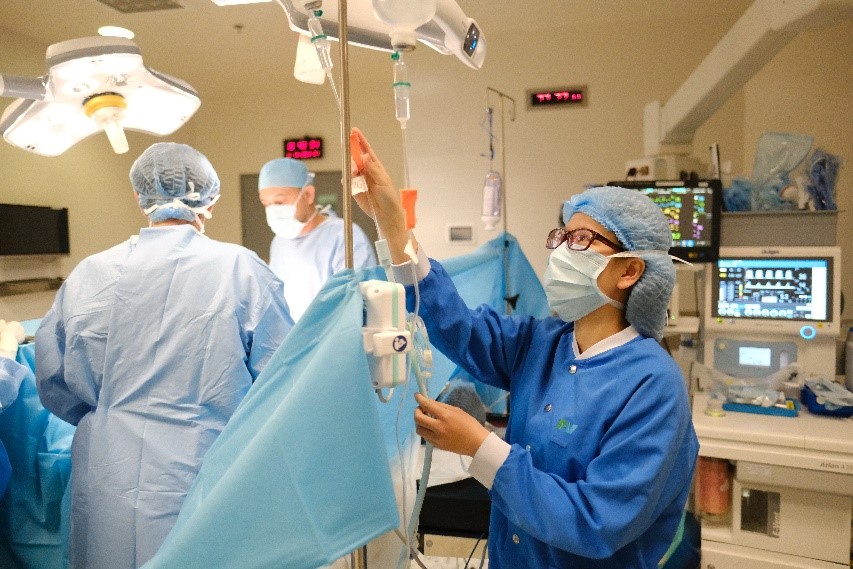Table of contents
The work of Anaesthesia Technicians seems to have no end. Surgery sometimes happens in short notice, and requires great concentration, sometimes it lasts many hours. Quiet, with little laughter, always busy, and with much pressure as the work requires high accuracy as well as accepting a great responsibility for patient safety.

A quiet yet stressful chain of work
Anaesthesia Technician is one of the quietest but most stressful jobs in the medical profession. Even with the global source, there are not many places with enough resources or materials that approach and research on the mental and physical difficulties of this work.
According to a 2019 report that surveyed more than 600 anaesthesia technicians in the UK, just before the appearance of COVID-19, 37% of participants experienced stress and 25% suffered from complete “burnout” at work. This is while the UK is ranked among the best countries for a supportive healthcare work environment.
FV Anaesthesia Technicians are divided into shifts, however a shift can be long and depends on the surgery they are involved in. During surgery, the anaesthesia technician’s role includes: patient assessment; preparing environment (operating room environment, anaesthesia and resuscitation medication, consumables, equipment, invasive and emergency intervention sets etc.); patient monitoring throughout the procedure (admission, surgery, and recovery); managing complications and emergency management regarding anaesthesia.
“Given being involved in such an important cycle, the role of the anaesthesia technician should be understood precisely as the anaesthesia nurse The common understanding anaesthesia technicians are just there to assist in monitoring and using machines during anaesthesia. We really accompany the patient through the whole process,” added Ms Hoang Thi Bich Van (Anaesthesia Technician Team Leader).

Bich Van is checking stock to replenish medicine at the Pharmacy Warehouse in the operating area
Sometimes, a task list for a surgery takes 60 minutes; sometimes it lasts more than 10 hours. Additionally, the technicians will inspect anaesthesia equipment in the operating room; managing the use and replenishment of consumables and specialised medication used in the operating room; active participation in the procedure to assist their colleagues and assisting in surgery to ensure the standard control for an operation.
People said an office job is an “8 hours looking at the screen”, it seems not very exciting and also brings fatigue. But normally it’s not just looking merely at the screen for 8 hours straight as there would be other tasks around. Meanwhile, an anaesthesia technician needs to observe the anaesthesia machine screens and the monitor continuously, together with other multiple devices, maintaining fluids, blood, and blood products. Besides observing the patient, under the shadow-less operating lamp, it can be a quiet place, with only the sound of the ventilator and the scalpel. It really takes a strong mind together with skill to work in this position.
Love is a prerequisite
Any job has inevitable disagreement at times, and the healthcare industry is no exception. Bich Van said, when it comes to surgery, between life and death, the disagreements require people to make a decision are really intense. Sometimes, the team can agree with each other, sometimes it is necessary to seek advice from a more senior member over the phone; sometimes the senior surgeons conduct urgent consultations in the operating room while a surgery is in progress. “However, in general, decisions must be on the principle of bringing the greatest benefit and safety for the patient; everyone must make great effort and come to a satisfactory solution,” said Ms Van.
Although at FV the patient is thoroughly assessed before surgery, all stages are planned and supervised by the anaesthesia doctors, sometimes complications can still arise during this procedure. The task of directly monitoring the patient and being able to respond to emergencies as soon as there are anaesthesia complications creates great pressure on the anaesthesia technician.

It takes good health and a love for the profession to stay with the job behind the green curtain
The pressure from work, plus the pressures of modern life, make many nurses (in general) quit. Particularly, the team of anaesthesia technician at FV, despite the small team we maintain the necessary stable number. Bich Van shared: “This job requires a love for the profession and devotion to work hard every day and accept the challenge of complicated surgeries; to make silent sacrifices behind the surgical curtain to help treating the patient”. That further proves the enthusiasm of the anaesthesia technician team for their career.
Many international doctors and local doctors, gave their compliments to FV team of Surgeons and Anaesthesia Technicians. Professor Donald Tan who performs corneal transplants, and Dr Ngo Long Phi who performs maxillofacial surgery, have commented that they feel secure when working with the FV anaesthesia team. “Maxillofacial surgery is very complicated, and it often takes a lot of time, without a skilled and professional anaesthesia team, to coordinate well with the surgeon, it is difficult to achieve a successful operation,” said Dr Ngo Long Phi.

Closely monitor the recovery to ensure the complete efficiency of a workflow
Every successful surgery and every healthy patient leaving the operating room, is the result of the team’s hard work. But it would be difficult for the patient to appreciate the important role of the anaesthesia technician, given their silent position behind the green curtain. Yet, for them, it nothing in comparison to their success in work. Because one successful case is one where they can help a patient overcome their disease.



